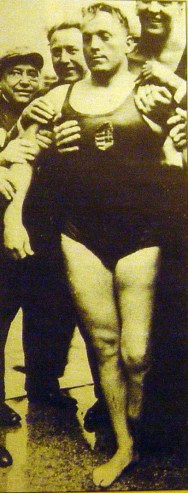
The 2016 Paralympics begin tonight. The “Parallel Olympics” began in 1960, sprouting from a movement that used sport to physically and mentally rehabilitate soldiers maimed or disabled in the Second World War. The story of Dr Ludwig Guttmann and the Games inaugurated at Stoke Mandeville Hospital is well-known, and is largely remembered as a common ancestor to the subsequent successes of disability sport.
Disabled athletes have however competed at the very top of elite sport for almost as long as the Modern Olympics. In an era where disabled people were often hidden from view, these pioneers demonstrated that paralysis, amputation or illness were not to stop them reaching the peaks of their fields, and in some cases the athletes’ disability served to harness their potential. Some, like Lis Hartel, built a legacy that inspired future athletic and therapeutic achievements. Others, such as George Eyser, are more enigmatic. Yet all of these stories remind us that disabled people have long resisted the societal imposition of limits upon themselves, and they still hold the power to challenge this notion today, as new stories are told in Rio over the coming weeks.
Ray Ewry – “The Frog Man”

“Ray Ewry wasn’t even supposed to walk,” writes Eric Adleson, but this American, born with Polio, won (at least) eight gold medals, a record that stood until Michael Phelps came to town. In fact, he never lost. Ewry competed in standing jump events, which sadly have long since fallen off the Olympic Roster. He leapt 1.66m in the standing high jump in Paris 1900, whilst also winning the standing long and triple jumps, leading Parisians to christen him “L’Homme Grenouille” – The Frog Man.
Aged eight, the orphan Ewry was wheelchair bound with ascending paralysis, and in an attempt to regain proper leg function, his therapist prescribed a series of exercises that extended and contracted the leg muscles. In this way Ewry learned to walk again, and year after year his legs grew stronger. By the time he had graduated from high school he had moved to crutches, which he was able to abandon the following year. The therapy he was prescribed holds many similarities to the modern elite training technique called plyometrics that increases explosive power in the legs. Ewry set out solely to walk again, but became stronger than everybody else.
George Eyser – Amputee Turner

The 1904 Olympics were held amidst the “Louisiana Purchase Exposition” World’s Fair in St. Louis. A commemoration of this great leap toward Manifest Destiny unsurprisingly became a disturbing parade of all that had driven United States expansion over the previous century. Amerindian, Filipino, African and Islander peoples were paid to “perform” their expected backwardness, exhibited like living artifacts to give lip-service to white American exceptionalism.
Central to the Expo was the “Philippine village,” wherein residents of the (US) occupied territory were made to live out – on display – a day-in-the-life of a rural Filipino. The great Haitian Jean Price-Mars, attending the festival, recalled seeing “two young [Filipino] Blacks…surrounded by an excited crowd that was subjecting them to all sorts of indignities.” James E. Sullivan’s Olympic showcase mimicked these proceedings, hosting a duet of “Anthropology Days” at St. Louis 2014, that took untrained, unsuspecting participants from the fair and made them compete in a series of events, and they inevitably struggled, even at so-called “savage-friendly” events like the javelin.
Sullivan proclaimed this farce to be evidence of white supremacy, whilst the massive medal haul achieved by the US (no wonder, when they provided 523 of the 630 Olympians, and were only challenged in 42 events) was heralded as proof that the USA represented the ideal of civilisation. Only six women competed, as the Olympics continued to clamp down on women in sport, and the sporting disaster drew on for over three months. It was crowned by the Marathon when the first man, Frederick Lorz, travelled by car for eleven miles, and competitors were deliberately denied water on the course because the organisers wished to test the limits of the dehydrated human body.

Amidst the chaos, German-American gymnast George Eyser won three golds, two silvers and a bronze. He had one leg; legend has it that as a child, he lost it after a run-in with a train. However Eyser, born in Danisch-Nienhof, was entrenched in the German “turnverein” culture of the 19th Century that encouraged gymnastic practice (or “turning”) as a means of achieving Germanic physical potential, and cemented itself in US society thanks to the millions of German migrants that arrived in the USA after 1848. Eyser was not a rich man – he worked as a bookmaker for his entire life – but had acquired an advanced prosthesis that enabled him to perform his craft. He competed in these Olympics as a member of the Concordia Turnverein, run out of St. Louis, and won the Rope Climbing and Parallel Bars outright, and tied for gold in the Horse Vault.
Eyser’s achievements are often forgotten among the trainwreck that was the “strangest” Olympics. A Wall Street Journal article even subsumed him within it, using the fact that a one-legged gymnast won three titles to suggest the entire Olympiad was as illegitimate as the Marathon. Although nearly all of Eyser’s rivals were based in the USA, the competition was not weak, and he collected his haul of medals by defeating some of the finest gymnasts of his generation. Eyser was the first amputee to compete in the games, but his actions after 1910 are barely known.

Olivér Halassy – The Greatest Halfback

Hungarian water polo halfback Olivér Halassy also ended up on the wrong side of public transport, losing his left foot in a streetcar accident, but came to be considered as the greatest halfback of his era, winning a silver and two golds as part of the fabled Hungarian water polo team of the 1930s, and scoring twenty goals along the way. These mighty Magyars also won three European titles, and in 1931, hours after their victory, Halassy jumped back in the pool and won the 1500m freestyle. The foot is an important tool in water polo to help stay afloat, to quickly change direction and to launch out of the water.
His final gold came in Berlin 1936, where Hungary, complete with a disabled swimmer, overcame the much-fancied, regime-backed German outfit who aimed to demonstrate able-bodied Aryan superiority. These performances posthumously earned Halassy a place in the Swimming Hall of Fame, but unfortunately his life was cut short in 1946. Late one evening, on the way back to his Budapest home, Halassy was shot dead by a Soviet soldier, leaving bereft his heavily-pregnant wife.
Karoly Takács

Two years after Halassy’s death, Károly Takács followed in his countryman’s footsteps and won gold in London 1948. In the 1930s, Takács was a world-champion pistol shooter and a sergeant in the Hungarian Army. However, in 1938, a defective grenade exploded in his pistol hand rendering it useless. Takács was hospitalised for a month, during which his hand was amputated up to the middle of his forearm. Upon release, he secretly began to train his remaining left hand in the art of pistol shooting, and a year later, he unexpectedly appeared at the World Championships. Legend has it that there he proclaimed “I didn’t come to watch, I came to compete.” He won. Nine years later, at the first Olympics held after the Second World War, Takács won gold with a world record in the 25-metre rapid fire pistol, and retained the title four years later in Helsinki.
Lis Hartel

The Danish equestrian Lis Hartel came from a family of hippophiles – she was a horsey person. In the early-1940s, Hartel became twice Danish dressage champion upon her unfortunately-named steed Gigolo. In 1944, whilst pregnant with her second child, Hartel contracted polio. The child, Anna, was born healthy but Hartel, aged 23, was left paralysed below the knee for the rest of her life, and also suffered damage to her thighs, arms and hands. After gaining enough strength to walk with arm crutches, Lis Hartel learned to ride again with the family horse, Jubilee, chosen for the task by her parents for her quiet temperament.
“They told her she would be lucky if she improves to walk on crutches again,” recalled her daughter Pernille Siesbye on Eurodressage. “She was lifted in the saddle and first guided in walk for her to get a feeling for the movement again. Step by step my Mum became more independent and finally rode on her own.” Horse riding requires strong leg and core strength for balance, and Hartel fell badly on many occasions as she struggled to adapt to her disability. Jubilee learned “that she had to react only to weight and back aids,” because Hartel now “rode with her back and by-gently shifting weight, because she was unable to use her legs in any way.” Hartel commanded Jubilee with very soft, subtle arm and leg movements. She did not have the strength for further force, but it suited the tasks of dressage and the gentle nature of Jubilee.
Soon they were competing again, but Hartel had to wait until 1952 to reach the Olympics. Before then, equestrian was only open to male military officers; a prohibition that was lifted for Helsinki for dressage, but not for jumping or eventing, which the Olympic committee still deemed too dangerous for women and civilians. Hartel entered the arena as one of the first four women to ever compete in Olympic equestrian. Her routine captivated the crowd, who were unaware of Hartel’s paralysis until she finished her routine and had to be carried off her horse by the gold medallist Henri St. Cyr. Hartel claimed the silver, becoming the first ever woman to medal in equestrian. She repeated the feat in Stockholm four years later.
Her greatest achievement (in her own eyes) was yet to come. Upon retirement, she founded the first Therapeutic Riding Centre in Europe, and through her advocacy work with the Polio Foundation, she is now “widely credited with inspiring a worldwide effort to better peoples’ lives through horses.” Hippotherapy has since been accepted as a highly effective therapeutic treatment for those with muscular afflictions such as cerebral palsy and multiple sclerosis, and has also been used for psychotherapy. The rhythm of horse riding replicates pelvic movements when walking, strengthening posture and thighs. Hartel died in 2009, but left a legacy that includes the rehabilitation of thousands, the demolition of equestrian’s glass ceiling, and the growth of dressage as a Paralympic sport. Her efforts live on also through the actions of the Lis Hartel Foundation.

Yes, They Could
The greatest Olympic moments – Jessie Owens, Ali, Carlos and Smith, de Lima in the Marathon, Kathy Freeman – they were not only sporting conquests but also triumphs over personal and societal pressures that stifled them. The wonder of the Paralympics is that every moment forms a public challenge against a world that denies the abilities of the disabled. Channel 4 calls them the Superhumans, but this article isn’t just to celebrate the remarkable individuals discussed above. Rather, the stories of Ewry, Eyser, Halassy, Takács, and Hartel demonstrate that people with physical disabilities have countered the derision of ableism for a very long time – long before the worthy events at Stoke Mandeville took place – and the Paralympic movement owes much to these pioneers.
